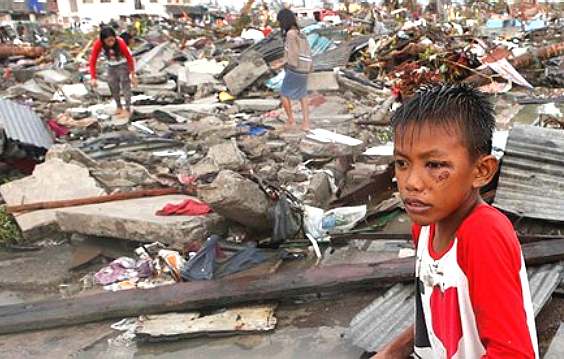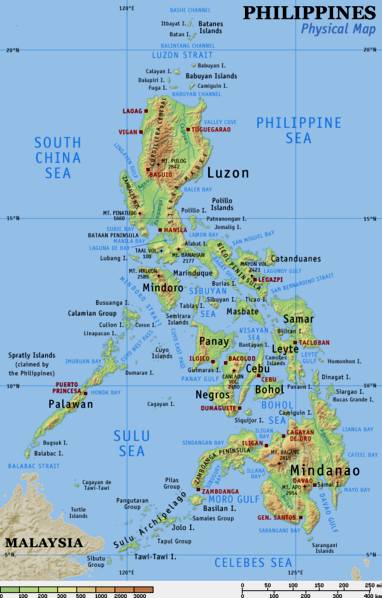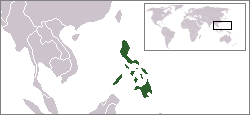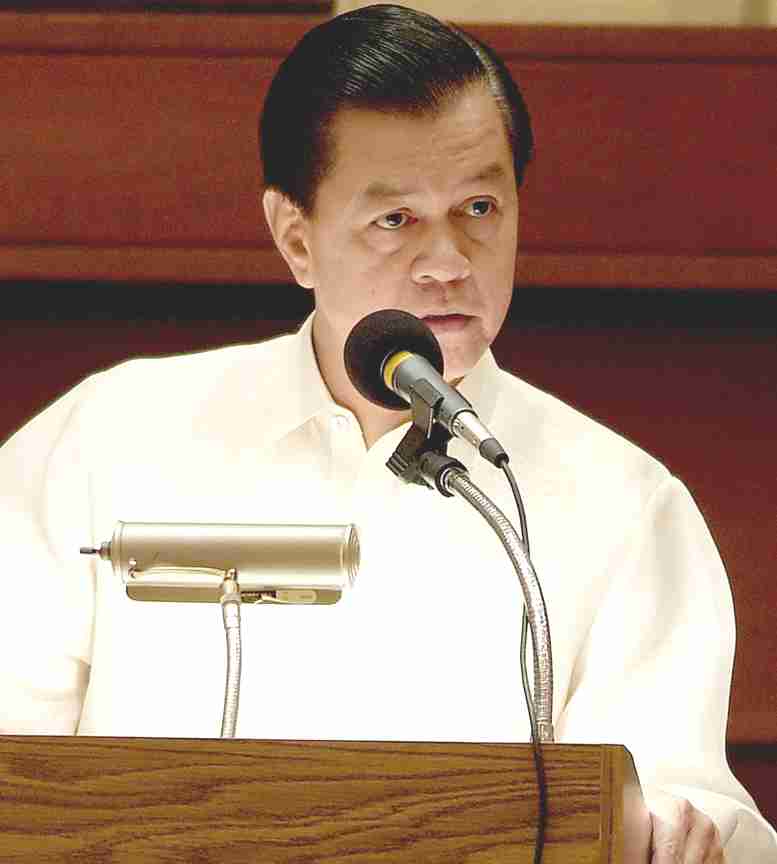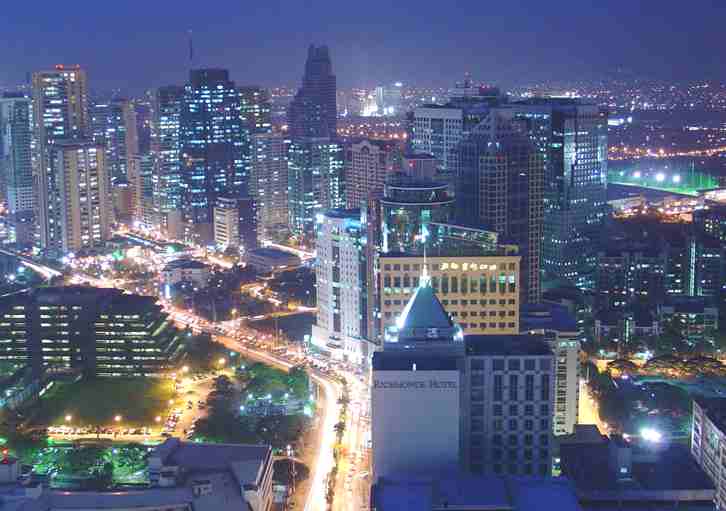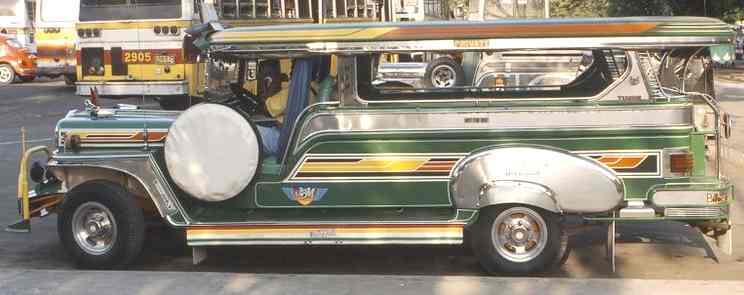|
PHILIPPINES
Please use our A to Z INDEX to navigate this site
|
|||||||||||||||||||||||||||||||||||||||||||||||||||||||||||||||||||||||||||||||||||||||||||||
|
Filipino children scour the debris for signs of the life they knew a few hours ago
NOVEMBER 2013 STRONGEST RECORDED TROPICAL CYCLONE
Typhoon Haiyan (known in the Philippines as Typhoon Yolanda) is unofficially the strongest recorded tropical cyclone to make landfall, with wind speeds up to 315 km/h (195 mph). The thirteenth named storm of the 2013 Pacific typhoon season, Haiyan originated from an area of low pressure several hundred kilometers east-southeast of Pohnpei in the Federated States of Micronesia on November 2. Tracking generally westward, environmental conditions favored tropical cyclogenesis and the system developed into a tropical depression the following day. After becoming a tropical storm and attaining the name Haiyan at 0000 UTC on November 4, the system began a period of rapid intensification that brought it to typhoon intensity by 1800 UTC on November 5. By November 6, the Joint Typhoon Warning Center (JTWC) assessed the system as a Category 5-equivalent super typhoon on the Saffir-Simpson hurricane wind scale; the storm passed over the island of Kayangel in Palau shortly after attaining this strength.
The Philippines (Filipino: Pilipinas), officially the Republic of the Philippines (Republika ng Pilipinas), is an island nation located in the Malay Archipelago in Southeast Asia, with Manila as its capital. It comprises 7,107 islands called the Philippine Archipelago, with a total land area of approximately 300,000 square kilometers or 116,000 square miles, making it the 72nd largest country by area.
Modern day Filipinos are mostly of Austronesian stock, although there are a number of Filipinos with Spanish, Chinese, American, and Arab ancestry.
Map of the Philippines
The country was named "Las Islas Filipinas" by Ruy López de Villalobos after King Philip II of Spain. Spanish colonial rule began in 1565 and lasted for about three centuries until the Philippine Revolution of 1896. The United States gained possession of the Philippines after the Spanish-American War in 1898 and ruled the country for about five decades. Philippine culture has many affinities with the West. Roman Catholicism is the predominant religion, and Filipino is an official language, along with English.
Archeological and paleontological evidence suggests that Homo sapiens existed in Palawan about 50,000 BCE. The Aetas are thought to have arrived in the Philippines more than 30,000 BCE through land bridges, possibly from China or the Andaman islands.
The ancestors of the vast majority of the Filipino people, the Austronesians from Taiwan, settled northern Luzon around 2500 BC. They spread to the rest of the Philippines and later colonized most of Maritime Southeast Asia and the Western Pacific Islands. Muslim, Chinese and Indian traders made contact with the Philippines during the course of the next thousand years until the arrival of the Europeans.
Sailing for the Spanish, the Portuguese explorer Ferdinand Magellan and his crew were the first Europeans to arrive in the archipelago in 1521. Magellan was killed by indigenous warriors in Mactan Island while being involved with political conflicts with Lapu-Lapu. Miguel López de Legazpi arrived in 1565 and formed the first Spanish settlements, and paved the way for colonization. Roman Catholic missionaries converted most of the inhabitants. In the next 333 years, the Spanish military fought off various local indigenous revolts and various external colonial challenges. Such challenges came from the British, Chinese, Dutch, French, Japanese, and Portuguese. The most significant loss for Spain was the temporary occupation of the capital, Manila, by the British during the Seven Years' War. The Philippines was ruled as a territory of New Spain from 1565 to 1821, before it was administered directly from Spain. The Manila Galleon which linked Manila to Acapulco, Mexico travelled once or twice a year, beginning in the late 16th century. The Philippines opened itself to world trade on September 6, 1834.
A propaganda movement began in the Spanish mainland, which included José Rizal. This was done in order to inform the government of the injustices of the administration in the Philippines as well as the abuses of the friars. In the 1880s and the 1890s, the propagandists clamored for political and social reforms, which included demands for greater representation in Spain. Unable to gain the reforms, Rizal returned to the country, and pushed for the reforms locally. Rizal was subsequently arrested, tried, and executed for treason on December 30, 1896. Earlier that year, the Katipunan, led by Andrés Bonifacio, already started a revolution, which was eventually continued by Emilio Aguinaldo, who established a revolutionary government, although the Spanish governor general Fernando Primo de Rivera proclaimed the revolution over in May 17, 1897.
The Spanish-American War began in Cuba in 1895 and soon reached the Philippines in 1898 when Commodore George Dewey defeated the Spanish squadron at the Manila Bay. Aguinaldo declared the independence of the Philippines on June 12, 1898, and was proclaimed head of state. As a result of its defeat in the War, Spain ceded the Philippines, together with Cuba, Guam and Puerto Rico to the United States. By 1899, the Philippine-American War ensued between the United States and the Philippine revolutionaries, which continued the violence of the previous years. The US proclaimed the war ended when Aguinaldo was captured by American troops on March 23, 1901, but the struggle continued until 1913. The country's status as a colony was turned into that of a commonwealth in 1935, which provided for more self-governance. Plans for independence in the next decade were underway, although this was briefly interrupted by the Pacific War when Japan occupied the country. The Philippines achieved independence from America on July 4, 1946.
Since 1946, the newly independent Philippine state has faced economic and political instability and various rebel groups. The late 1960s and early 1970s saw the rise of student activism and civil unrest. Ferdinand Marcos was, then, the elected president. Barred from seeking a third term, Marcos declared martial law on September 21, 1972 and ruled the country by decree. Marcos extended both his power and tenure by force. His authoritarian rule became marred with unmitigated, pervasive corruption, cronyism and despotism.
Opposition leader Benigno Aquino, Jr. was assassinated on August 21, 1983 upon returning from exile. In January 1986, Marcos allowed for a "snap" election, after large protests. The election was believed to be fraudulent, and resulted in a standoff between military mutineers and the military loyalists. Protesters supported the mutineers, and was accompanied by resignations of prominent cabinet officials. Corazon Aquino, the wife of Benigno Aquino, Jr., was the recognized winner of the snap election. She took over government, and drafted a new constitution, after the 1986 EDSA Revolution. Marcos, his family and some of his allies were exiled to Hawaii.
The return of democracy and government reforms after the events of 1986 was hampered by massive national debt, government corruption, coup attempts, a communist insurgency, and a Muslim separatist movement. The economy improved during the administration of Fidel V. Ramos, who was elected in 1992. However, the economic improvements were negated at the onset of the East Asian financial crisis in 1997. The 2001 EDSA Revolution led to the downfall of the following president, Joseph Estrada. The current administration of president Gloria Macapagal-Arroyo has been hounded by allegations of corruption and election rigging.
Gloria Macapagal-Arroyo, the current President
Politics and government
The government of the Philippines is organized as a presidential-unitary republic, where the President functions as head of state, the head of government, and the commander-in-chief of the armed forces. The president is elected by popular vote to a 6-year term, during which he or she appoints and presides over the cabinet of secretaries.
The bicameral Congress comprises the Senate and the House of Representatives; members of the former are elected at large and those of the latter by geographical district. The 24 senators serve 6-year terms, with half retiring every three years, while the House of Representatives comprises 250 members serving 3-year terms.
The judicial branch of government is headed by the Supreme Court, with a Chief Justice as its head and 14 associate justices, all appointed by the President from nominations submitted by the Judicial and Bar Council. Other courts include the Court of Appeals, the Regional Trial Courts and the Metropolitan Trial Courts.
As of June 2006, President Gloria Macapagal-Arroyo is hoping to get agreement to amend the constitution to a unicameral parliament under a federal setting similar to the German constitution. The country would be split into "states" with each one having a local legislature responsible for certain functions. Included in the amendments are plans to remove/ease the current ban on foreign ownership of property, land and commercial organizations in the Philippines. Plans have been announced to decentralize government by moving departments from Manila to the provinces, such as the Department of Tourism to Cebu City, the Department of Foreign Affairs to Angeles City, and the Department of Agrarian Reform to Iloilo City.
The Philippines is a founding and active member of the United Nations since its inception on October 24, 1945 and is a founding member of the Association of Southeast Asian Nations (ASEAN).
Noli de Castro, the current Vice President
The Philippines is also a member of the East Asia Summit (EAS), an active player in the Asia-Pacific Economic Cooperation (APEC), the Latin Union and a member of the Group of 24. The country is a major non-NATO ally of the U.S., but also a member of the Non-Aligned Movement.
The Philippines, along with the nation of Malta, is one of only two nations in the world where all civil marriages are for life, because civil divorce (for violations coming after the marriage) is banned, although annulment (for violations before the marriage, although it may manifest itself after the solemnization) is permitted.
The Philippines is currently in a dispute with Taiwan, China, Vietnam and Malaysia over the oil- and natural gas-rich Spratly Islands and Scarborough Shoal, and with Malaysia over Sabah. The Sultan of Sulu, who received Sabah as a gift in 1703 having helped the Sultan of Brunei defeat a rebellion, has given the Philippine Government power to reclaim his lost territory. To this day, the Sultan of Sulu's family receives "rental" payments for Sabah from the Malaysian government.
Administrative divisions
The Philippines is divided into three geographical areas: Luzon, Visayas, and Mindanao. It has 17 regions, 80 provinces, 117 cities, 1,501 municipalities, and 41,982 barangays.
Most government offices establish regional offices to serve the constituent provinces. The regions themselves do not possess a separate local government, with the exception of the Autonomous Region in Muslim Mindanao.
On July 24, 2006, the State of the Nation Address of President Arroyo announced the proposal to create 5 economic super regions in order to concentrate on the economic strengths in a specific area.
¹ Names are capitalized because they are acronyms, containing the names of the constituent provinces or cities (see Acronyms in the Philippines).
² These regions formed the former Southern Tagalog region, or Region IV.
³ Palawan was moved from Region IV-B as known as MIMAROPA to Region VI. From November 2005, Region IV-B would be called MIMARO, decreased from 5 to 4 provinces and Region VI are increased from 7 to 8 provinces.
Geography
The Philippines constitutes an archipelago of 7,107 islands with a total land area of approximately 300,000 square kilometres (116,000 sq. mi). It lies between 116° 40' and 126° 34' E. longitude, and 4° 40' and 21° 10' N. latitude, and borders the Philippine Sea on the east, on the South China Sea the west, and the Celebes Sea on the south. The island of Borneo lies a few hundred kilometers southwest and Taiwan directly north. The Moluccas and Sulawesi are to the south, and Palau is to the east beyond the Philippine Sea.
The islands are commonly divided into three island groups: Luzon (Regions I to V, NCR and CAR), Visayas (VI to VIII), and Mindanao (IX to XIII and ARMM). The busy port of Manila, on Luzon, is the national capital and second largest city after its suburb Quezon City.
The local climate is hot, humid, and tropical. The average yearly temperature is around 26.5°C (79.7°F). There are three recognized seasons: Tag-init or Tag-araw (the hot season or summer from March to May), Tag-ulan (the rainy season from June to November), and Taglamig (the cold season from December to February). The southwest monsoon (May-October) is known as the "habagat" and the dry winds of the northeast monsoon (November-April) as the "amihan". The country itself is udergoing desertification in place like Sorsogon, Baguio, Davao and the Sierra Madre mountain range.
Most of the mountainous islands used to be covered in tropical rainforest and are volcanic in origin. The highest point is Mount Apo on Mindanao at 2,954 metres (9,692 ft). There are many active volcanos such as Mayon Volcano, Mount Pinatubo, and Taal Volcano. The country also lies within the typhoon belt of the Western Pacific and about 19 typhoons strike per year.
Lying on the northwestern fringes of the Pacific Ring of Fire, the Philippines experiences frequent seismic and volcanic activities. Some 20 earthquakes are registered daily in the Philippines, though most are too weak to be felt. The last great earthquake was the 1990 Luzon earthquake.
The longest river is the Cagayan River of northern Luzon. The nearly circular Manila Bay, is connected to the Laguna de Bay by means of the Pasig River. Subic Bay, the Davao Gulf and the Moro Gulf are some of the important bays. Transversing the San Juanico Strait is the San Juanico Bridge, that connects the islands of Samar and Leyte.
San Miguel Avenue in Ortigas Center, Mandaluyong - Pasig City Boundary
Economy
The Philippines is a developing country with an agricultural base, light industry, and service-sector economy. The Philippines has one of the most vibrant business process outsourcing (BPO) industries in Asia. Numerous call centers and BPO firms have infused momentum into the Philippine market, generating thousands of jobs, including Fortune 500 companies.
The resiliency of the Philippine economy due to low foreign inflows and an agriculture-based economy allowed it to snap back from international crises as evidenced by 3% growth in 1999 and accelerated to 4% in 2000. By 2004, the Philippine economy catapulted to over 6% growth after the East Asian financial crisis of the late 1990s. President Gloria Macapagal-Arroyo pledged to turn the country into a First World state by 2020.
Government initiatives are designed to match the pace of development in the newly industrialized countries (NICs) of East Asia. Economic strategies are implemented to manage a public debt comprising 93% of the GDP. This priority manifests as a budget allocation set higher than the budget for education and defense combined. The Philippine middle class is essential to economic prosperity. Although proportionately smaller, the Philippine middle class is scheduled to grow.
Strategies for streamlining the economy include improvements of infrastructure, more efficient tax systems to bolster government revenues, furthering deregulation and privatization of the economy, and increasing trade integration within the region and across the world.
On November 1, 2005, a newly expanded value added tax (E-VAT) law was instituted as a measure to bridle the rising foreign debt and to improve government services such as education, healthcare, social security, and transportation. As of 2006, The Philippines' economic prosperity also depends in large part on how well its two biggest trading partners' economies perform: the U.S. and Japan.
The Philippines is a member of the Asian Development Bank, World Bank, International Monetary Fund, and other international economic associations, such as the Asia Pacific Economic Cooperation (APEC), the World Trade Organization (WTO), the Colombo Plan, and the G-77.
In 2005, the Philippine peso was said to be Asia's best-performing currency. The Philippines' 1st quarter GDP growth was within the government's programmed growth of 5.5% buoyed by the rebound of the agriculture sector and a strong service sector performance however, the economy is still vulnerable to high world oil prices and political instability. There are few promising developments though: one is the strong fiscal performance that the government has put in place; another is the mining boom, which will help generate additional revenues and additional jobs but may permanently damage the environment. The country’s export rose by more than 15% in January-April this year, while investments increased by $2 billion over that of the same four-month period last year.
Despite the growing economy, the Philippines will have to address several chronic problems in the future. Income inequality remains persistent; about 30 million people lived on less than $2 per day in 2005. China and India have emerged as major economic competitors, siphoning away investors who would otherwise have invested in the Philippines, particularly telecom companies. Regional development is also somewhat uneven, with the main island Luzon and Metro Manila gaining most of the new economic growth at the expense of the other regions.
The Philippines is a significant source of migrant workers; as of 2004, the Philippine government has estimated that there are over 8 million Overseas Filipinos while independent estimates by various Philippine civic organizations estimate the number at 11 million. Overseas Filipinos sent home a record $10.7 billion in 2005. The Filipino diaspora is present in 190 nations worldwide.
Population growth of the Philippines
Demographics
The Philippines is the world's 13th most populous country, with a population of over 85 million as of 2005. Roughly two-thirds reside on the island of Luzon. Manila, the capital, is the eleventh most populous metropolitan area in the world. The literacy rate was 92.5% in 2003, and about equal for males and females. Life expectancy is 69.91 years, with 72.28 years for females and 66.44 years for males. Population growth per year is about 1.92%, with 26.3 births per 1,000 people. In the 100 years since the 1903 Census, the population has grown by a factor of eleven. This represents a much faster rate of growth than other countries in the region (Indonesia has grown five-fold over the same period).
Ethnic groups
The people of the Philippines are called Filipinos. Most Filipinos are descended from the various Austronesian-speaking migrants who arrived in successive waves over a thousand years ago from Southeast Asia. These ethnic Filipinos are divided into various ethnolinguistic groups, the three most numerous being the Bisaya, Tagalogs, and the Ilocanos. They are genetically closely related to the Taiwanese aborigines, Malays of Malaysia and Indonesia, and the Polynesians. The Negritos or Aetas are the aboriginal inhabitants of the Philippines, and number less than 30,000 people (0.03%). Filipinos of Chinese descent, who had been settling in the Philippines since pre-Hispanic times, currently forms the largest non-Austronesian ethnic group, claiming about 2% of the population. Other significant minorities include Americans, South Asians, and Europeans (particularly Spaniards). There are also numerous Arabs and Indonesians in the country, especially in Mindanao. According to a Stanford University small-sample study, about 3.65% Filipinos are partly of Spanish, Mexican or other European ancestries.
Languages
More than 170 languages are spoken in the country, almost all of them belonging to the Western Malayo-Polynesian language group of the Austronesian language family. According to the 1987 Constitution, Filipino, heavily based on Tagalog, and English are both the official languages. The twelve major regional languages are the auxiliary official languages of their respective regions, each with over one million speakers: Tagalog, Cebuano, Ilokano, Hiligaynon, Waray-Waray, Bikol, Kapampangan, Pangasinan. Kinaray-a, Maranao, Maguindanao and Tausug. English is used by some Filipinos as their first language, particularly those belonging to the upper echelons of society.
The Lan-nang-oe variant of Min Nan Chinese dialect is widely spoken by the country's Chinese minority
The use of Spanish in the Philippines as the original official language of the country for more than three centuries, has significantly declined. Currently, only a few Spanish Mestizo families speak it as their first language, though many others use it together with Tagalog and English. Both Spanish and Arabic are used as auxiliary languages in the Philippines. The use of Arabic is prevalent among the Filipino Muslims. It is taught in madrasah (Muslim) schools.
Religion
The Philippines is the fifth-largest Christian nation, after the United States, Brazil, Mexico, and Russia. About 85% of all Filipinos are Christians: 80% belong to the Roman Catholic Church, and about 5% belong to various Protestant and other Christian denominations. Although Christianity is a major force in the culture of the Filipinos, indigenous traditions and rituals still affect religious practice.
Approximately 15% of Filipinos are Muslim. They primarily live in parts of Mindanao and the Sulu archipelago. Most lowland Muslim Filipinos practice normative Islam, although the practices of some Mindanao's hill tribe Muslims reflect a fusion with animism. The Muslims have resisted conquest and conversion for centuries by the Spanish and the Americans. Various Muslim groups have been waging a decades-long armed campaign against the Philippine government for political self-determination.
There are also small populations of Buddhists, Hindus, and Jews.
Philippine Jeepney
Culture
Filipino culture is largely a fusion of the indigenous traditions of the Philippines, with the Hispanic and American cultures. It has also been significantly influenced by Chinese, Indonesian and Indian cultures.
The Hispanic influences in Filipino culture are largely derived from the culture of Spain as a result of over three centuries of Spanish colonial rule through Mexico City. These Hispanic influences are most evident in Roman Catholic Church religious festivals. Filipinos hold major festivities known as barrio fiestas to commemorate their patron saints. The most visible Hispanic legacy, is the prevalence of Spanish surnames among Filipinos. This peculiarity, unique among the people of Asia, came as a result of a colonial decree for the systematic distribution of family names and implementation of the Spanish naming system on the inhabitants of the Philippines. A Spanish surname in the Philippines doesn't necessarily denote Hispanic heritage. But there are many other traces of Spanish culture in the country, such as names of countless streets, towns and provinces, which are also named in Spanish. Filipino cuisine is also heavily influenced by Spanish cuisine.
The Chinese influences in Filipino culture are most evident in Filipino cuisine. The prevalence of noodles, known locally as mami, are a testament of the Chinese cuisine. Other Chinese influences include linguistic borrowings and the occasional Chinese derived surnames.
The use of English language in the Philippines is contemporaneous and is America's visible legacy. The most commonly played sport in the Philippines is basketball. There is also a wide "imitation" of American cultural trends, such as the love of fast-food; many street corners boast fast-food outlets. Aside from the American commercial giants such as McDonald's, Pizza Hut, Burger King, and KFC, local fast-food chains have also sprung up, including Goldilocks, Jollibee, Greenwich Pizza, and Chowking. Modern day Filipinos also listen to contemporary American music and watch American movies.
In spite of this, native moral codes, respect of family, veneration of elders, and friendliness, all remain intact. Filipinos honor national heroes whose works and deeds contributed to the shaping of the Filipino nation. José Rizal is the most celebrated ilustrado, a Spanish-speaking reformist visionary whose writings contributed greatly in nurturing a sense of national identity and awareness. His novels Noli Me Tangere and El Filibusterismo originally written in Spanish, are required readings for Filipino students, and provide vignettes of colonial life under the Spanish rule. They give a sense of Filipino identity and historical continuity. Ninoy Aquino, the charismatic leader against the Marcos dictatorship, is a highly revered martyr of the People Power revolution.
As with many cultures, music and leisure activities are an important aspect of the Filipino society. Various sports are also enjoyed, including boxing, basketball, badminton and billiards being popular games in the country.
SECURITY & DEFENSE
Philippine defense is handled by the Armed Forces of the Philippines and is composed of three branches: the Air Force, the Army, and the Navy (including the Marine Corps). Civilian security is handled by Philippine National Police under the Department of the Interior and Local Government (DILG).
FOREIGN RELATIONS
References
Official
Maps Other
Solar Cola drinkers care about planet earth
.. Thirst for Life
(330ml Planet Earth can)
|
|||||||||||||||||||||||||||||||||||||||||||||||||||||||||||||||||||||||||||||||||||||||||||||
|
This website is Copyright © 1999 & 2024 Max Energy. The bird logos and name Solar Navigator are trademarks. All rights reserved. All other trademarks are hereby acknowledged. Max Energy is an educational charity working hard for world peace.
|
